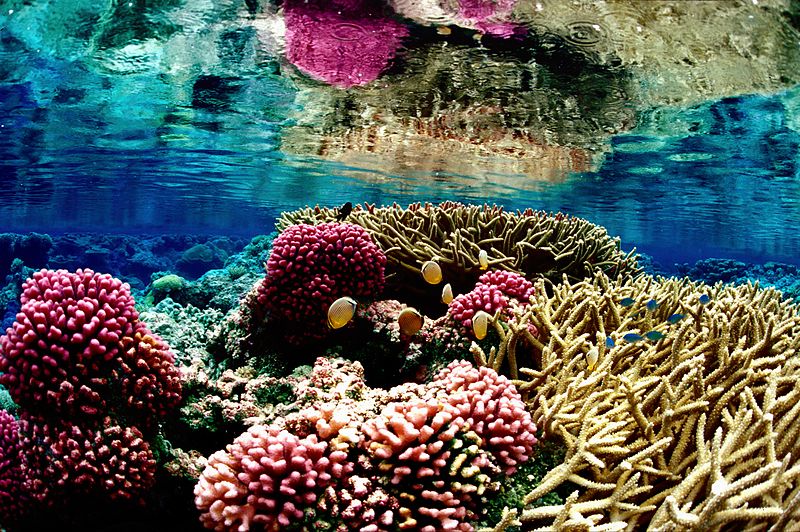It’s like a team of obsessive compulsive scientists turned up to capture a magic show in slow-mo
They descended on Palmyra Atoll in 2009 and kept going for ten years, taking 1,500 photos across eighty plots of corals. They looked at all the living things on the ocean floor, and not just the hard corals, but the algae, the microalgae, and the turf. They followed plots where waves crashed and plots that were calm. Then they went through the photos with detailed digital-tracing and image analysis and tracked them — not just through one, but two full bleaching cycles and what they found was recovery. Stability!
In May this year their 10-year study of Palmyra Atoll was finally published
Palmyra is an isolated atoll, 1,300 km south west of Hawaii, with a tiny population. It’s about as pristine as anything can get, unaffected by human pollution, except of course, for CO2 — that fertilizer from the sky which is everywhere. If it was a problem, this was a good place to find out.
In 2015 a savage pool of warm water arrived that bleached not just ten or twenty percent of the corals but blitzed right through ninety percent. It must have looked like a graveyard. But one year later, only 10% had actually died. Within two years the reef was restored to “pre-bleaching levels”. It’s almost like reefs have been doing this for millions of years. Like corals are the tropical weeds of the ocean?
Even the researchers can’t contain their relief. The study authors are describing it as a remarkable recovery, one which gives everyone hope. It’s couched in the qualifier that this happened in an untouched wilderness, and that reefs closer to fertilizers, fishing and man-made pollution don’t start from such a high point and aren’t as well equipped to deal with trouble. They may have a point, but the study puts a big hole in the idea that rising CO2 is killing coral reefs already. After all, the CO2 was there before, during and after the bleaching and getting higher every year — inasmuch as it caused death, it also caused recovery. The reefs were fine.
The most important point is that reef systems are resilient, and that bleaching is not necessarily a big deal.
Thanks for the tip to Graham Young of the AIP
I’m sold. Can anyone get me tickets to Palmyra?

Palmyra Atoll Reef | Photo credit: Jim Maragos/U.S. Fish and Wildlife Service
Central Pacific Coral Reef shows remarkable recovery despite two warm-water events
Steven Koppes, Scripps
The largest global coral-bleaching event ever documented struck the world’s oceans in 2014 and lasted until 2017. The onset of this abnormal whitening condition spawned widespread gloom-and-doom news reports about its calamitous effect on Australia’s Great Barrier Reef and more general predictions of coral reef extinction by 2050.
But a new 10-year study from Palmyra Atoll in the remote central Pacific Ocean shows that reefs outside the reach of local human impacts can recover from bleaching.
“One year after each bleaching event, we did see signs of coral decline at some of the sites, but within two years this was restored,” said Adi Khen, a Scripps Oceanography PhD candidate and lead author. The research team of current and former members in marine ecologist Jennifer E. Smith’s laboratory saw only a small net change in the reef’s coral and algae populations after a decade. Khen, Smith and four co-authors published their results in the journal Coral Reefs.
“During the warming event that occurred in 2015, we saw that up to 90% of the corals on Palmyra bleached but in the year following we saw less than 10% mortality,” Smith reported.
Even the researchers were relieved and enthused:
New study gives hope that coral can recover
Bree Steffen, August 5
“I think most people are really fatigued and frankly kind of given up on the ability to do anything to save coral reefs or other marine ecosystems,” Smith said. “And so to have a case study where we can see that the reefs on Palmyra today probably looked the same way they did, you know, several decades ago or even a century ago. Even when it gets hit with a warm water event, there are impacts, but those species and the individuals that are there are able to recover really quickly.”
It’s a bit obsessive compulsive, but what good scientist isn’t?
They took 1,500 photos of the same reefs to keep track of the changes, and then someone had to squish them all together. 🙂
Abstract
The prevalence of coral bleaching due to thermal stress has been increasing on coral reefs worldwide. While many studies have documented how corals respond to warming, fewer have focused on benthic community responses over longer time periods or on the response of non-coral taxa (e.g., crustose coralline algae, macroalgae, or turf). Here, we quantify spatial and temporal changes in benthic community composition over a decade using image analysis of permanent photoquadrats on Palmyra Atoll in the central Pacific Ocean. Eighty permanent plots were photographed annually between 2009 and 2018 on both the wave-exposed fore reef (FR, 10 m depth, n = 4 sites) and the wave-sheltered reef terrace (RT, 5 m depth, n = 4 sites) habitats. The El Niño events of 2009–2010 and 2015–2016 resulted in acute thermal stress and coral bleaching was observed at both reef habitats during these events. Across 10 yr and two bleaching events, the benthic community structure on Palmyra shows evidence of long-term stability. Communities on the RT exhibited minimal change in percent cover of the dominant functional groups, while the FR had greater variability and minor declines in hard coral cover. There was also spatial variation in the trajectory of each site through time. Coral cover decreased at some sites 1 yr following both bleaching events and was replaced by different algal groups depending on the site, yet returned to pre-bleaching levels within 2 yr. Overall, our data reveal the resilience of calcifier-dominated coral reef communities on Palmyra Atoll that have persisted over the last decade despite two bleaching events, demonstrating the capacity for these reefs to recover from and/or withstand disturbances in the absence of local stressors.
REFERENCE
Adi Khen, Maggie D. Johnson, Michael D. Fox, Samantha M. Clements, Amanda L. Carter & Jennifer E. Smith (2022) Decadal stability of coral reef benthic communities on Palmyra Atoll, Coral Reefs volume 41, pages 1017–1029.
